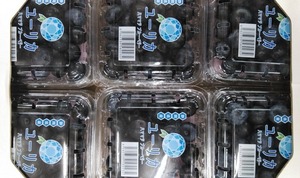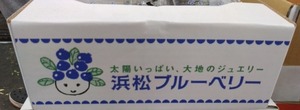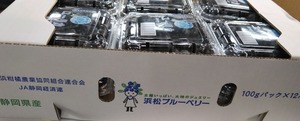"Native place" (Miyakoda Town, Kita Ward, Hamamatsu City), where you can experience the traditional lifestyle of Satoyama Landscape, won the Minister of the Environment's Award at the 10th Good Life Awards sponsored by the Ministry of the Environment. Received the only top award in Japan for "A project to recognize and spread awareness of efforts that embody the philosophy.'' When you win a Good Life Award, you can join a network of past award-winning organizations. In addition to connections between award-winning organizations, networks with governments, mass media, companies, research institutes, etc. appear to be expanding.
Miyakoda Nature School (Food that builds a strong body, and a natural environment such as forests and villages that bring out instincts. Adding communication between parents and children creates more quality time than we could have imagined.)
【Product name】
Hamamatsu Blueberry(Eureka)
【Type】
Vaccinium corymbosum. ‘Eureka’
【Wholesale area】
Miyakoda Town, Kita Ward, Hamamatsu City, Shizuoka Prefecture (Maruhama Citrus Agricultural Cooperative Federation, JA Shizuoka Keizairen)
【Origin of name】
Greek for “great discovery”
【Major features】
Move your white delicate legs to chase mosquitoes(Culicidae); Move your white delicate legs and chase mosquitoes. Onzukayama Tomb-Tomb A-7 : City-designated historic site, designated in 1982. Located in the mountains on the west side of Tokoha University Hamamatsu Campus in miyakoda Town. A circular burial mound with a diameter of about 11 m and a height of about 3 m. A T-shaped horizontal hole type stone chamber opens to the south. It is famous as a building in the first half of the 7th century. Suiko period (i.e. the Asuka period, esp. under the reign of Empress Suiko, approx. 592-628 CE) : Although there are various theories as to when the Asuka period in the history of Japan began but it is general to regard enthronement of Emperor Suiko as the beginning. During the Asuka Period, Asuka culture prospered in the age of Empress Suiko and Hakuho culture flowered in the ages of Emperor Tenmu and Empress Jito. In Japan there were two examples of Shosei which were, Prince Naka no Oe (Emperor Jomei and Empress Saimei's Prince, later called Emperor Tenchi or Tenji ; 626-671 CE, reigning: 668-671 CE) and Emperor Jito (Emperor Tenchi's Princess, Emperor Tenmu's Empress and later called Emperor Jito), however there are some opinions that the three examples of Empress Jingu and Iitoyo no Himemiko (Princess Iitoyo) and Ahe no Himemiko (Princess Ahe) were considered as Shosei. Although the blood line of the Emperor Tenmu completely vanished from the Imperial line, a descendant of Imperial Prince Toneri was given the family name of KIYOHARA no Mahito and became the patriarch of the Kiyohara clan, and a descendant of Prince Takechi was given the family name of Takashina no MAHITO and became the patriarch of the Takashina clan; they both prospered for a long time. “Hamamatsu Blueberry”, From production to wholesale land - “Miyakoda Town, Kita Ward, Hamamatsu City, Shizuoka Prefecture.” The nationwide demand for mandarin oranges has increased since the 1955's. Northern Hamamatsu City for nationwide Mandarin Orange cultivation-A citrus-specialized pioneering agricultural cooperative was established on the eastern shore of Lake Hamana. Then, citrus farmers living in Shimizu City and Shizuoka City enter the Area : Then, they settled as a group of farmers and citrus cultivation became popular. Therefore, it was urgent to improve the “mandarin orange” sorting plant. In December 1968, hamamatsu city comprehensive agricultural cooperative lined up-Beginning Pioneer Agricultural cooperative, Shizuoka City agricultural cooperative, Shimizu City agricultural cooperative, Shizuoka Prefect. Federation of Economic Organizations(Former Shizuoka Citrus Union), Jointly funded by Shizuoka Pioneer Federation-Maruhama Citrus Federation of Agricultural Cooperatives Organized. After 1975, when it was first established, the production area was 350 ha. A major production area of-Policy of reducing acreage (under cultivation) : Mandarin orange production is excessive nationwide. Liberalization of ‘orange’ imports in the 1980s and 90s. In recent years, the aging of union members has become more serious, and the number of closed parks is increasing. Organized by producers who will be the leaders from 2009 - “Maruhama Activation Study Group” was established. Maruhama's signature variety : Katayama Citrus unshiu ;『片山温州』Originally, it's said to be a variety of unknown branches that was discovered in Tokushima Prefecture around 1955(The son of a researcher who was involved in a great deal was between 1954 and 1955. Tokushima Agriculture, Forestry, and Fisheries Technology Support Center: Former fruit tree test site). It's unknown what the original variety is, but it's currently grown mainly in Hamamatsu City, Shizuoka Prefecture. Only a small portion is grown in Shizuoka Prefecture, and Maruhama is famous. A source of vitality full of ancestral power and quest. An excellent collaboration between Tokushima and Shizuoka prefectures.(“Katayama Citrus unshiu”, a middle-aged orange mandarin variety, is harvested from December to January. For the full year, shipments will begin in late September and are expected until April of the following year. Greenhouse mandarin oranges in Tokushima Prefecture are heated in a greenhouse from mid-October to December. Pure white flowers bloom in winter, and fresh fruits are harvested from late April.)Shipping time. Late December-early February, Main production areas. Hamakita district, "Mikatahara" / Miyakoda district. People-friendly Miyakoda: With the opening of the Shin Tomei Expressway, we have been working on the "Issha One Village Shizuoka Campaign" with "NEXCO Central Japan" as a partner since September 2010. It seems that there are active exchanges with urban residents who utilize local resources, such as picking and harvesting oranges, farming experiences such as growing vegetables, and planting cluster amaryllis. Since ancient times, there have been many farmers in the Miyakoda area, and it seems that regional connections have been made, such as exchanging harvests and skirting, greetings in the morning and evening, and exchanging information on crop management. With the establishment of the Hamamatsu Smart Interchange on the Shin Tomei Expressway in the Miyakoda area, it seems that the motto is to welcome visitors from afar with kindness and warmth. Located in the lower reaches of the Miyakoda River in Kita Ward, Hamamatsu City, about 40 minutes by car from the center of Hamamatsu City, it is a rural area with rural scenery along the Miyakoda River and mandarin orange gardens in the hills on the north side. Blessed with clear streams and abundant greenery, it seems that the local residents carefully protect the landscape, which is rich in seasonal changes, with genji fireflies dancing in the summer and cluster amaryllis blooming in the fall. Even in children, the skin is easy to peel and the sugar content is high. They have a long life and are loved by everyone. Sales measures pushed to the front and creation of mascot characters. We are also looking for new sales that make use of it. “Maruhama blueberries”, Drip irrigation system : Cultivation technology that supplies all nutrients and water with nutrient solution (water in which fertilizer is dissolved). Unlike normal Soil cultivation, it is easy to calculate fertilizer components. In addition, the necessary nutrition can be reliably provided. What kind of nutrition do you give? All producers have introduced this technology and are studying it daily. Also, since it is taken directly into the mouth, there are as few pesticides as possible. Pest control-Assistance using adhesive sheets, releasing natural enemies that eat pests into the house, etc. with introduced pest control without “pesticides”. It is a very delicate fruit that can be easily damaged by a slight impact. Only those that are hand-picked and carefully selected go to the fruit sorting area. Fruit sorting work - Divide the size, remove damage and immature fruits, pack. Also at this time, for hygiene, wear pay close attention to, hats, masks, rubber gloves, etc. I try to prevent foreign matter from entering. The resulting pack is packed in a box and shipped to each market. Southern highbush blueberry ; Eureka-Mountain Blue operates two farms(MBO Company)in Northern NSW and another site in Atherton, Far North Queensland. All NSW fruit is packed at its own state of the art packaging facility in Tabulam, and is made available for a variety of supermarket and export customers. Production from our own farms is supplemented by our network of growers around Australia who grow our proprietary genetics. The Eureka Blueberry was discovered as a chance seedling by Ridley Bell (Mountain Blue Founder) in 2008. Mr. Ridley applied his wealth of experience to naturally cross two blueberry varieties which by surprise resulted in this jumbo blueberry without the use of any genetic modification. “Eureka Blueberries” are larger in size without compromising their sweet, fruity flavour and crisp-juicy bite, giving you a wonderful breakfast eating sensation. The Eureka “Brand” is exclusive to Coles who support the brand heavily through catalogue during our main season and, in 2016, were so happy with our product that they awarded us with, product innovation of the year. Sold exclusively at Coles in Victoria, Tasmania New South Wales and Queensland. etc.
Eureka Blueberry is grown by Mountain Blue Frms of Australia. Very sweet, fruity and luxurious large fruit that can be harvested during the Goku-Wase season. The fruits are very hard and the crispy texture is soothing. Very sweet, fruity and very long lasting. It is no exaggeration to say that there is no other blueberry with such elegant sweetness and luxury. "Eureka" is a Greek word meaning a great discovery.
At Hamamatsu Blueberries, it seems that they are constantly searching for varieties suitable for the land of Hamamatsu, from the Southern high bush blueberries of the Wase line to the rabbit eye blueberries of the late-maturing line. Since it is cultivated in various cultivation systems such as grown in heated greenhouse, unheated green house, and open field, it seems that it is handled for a long period from mid-March to mid-July.
Hamamatsu Blueberries are shipped early and are of high quality and highly evaluated by the market. In 2011, it was certified as "Shizuoka Food Selection" by Shizuoka Prefecture. Blueberries are a very delicate fruit. It seems that it may be damaged immediately by a slight impact. Maruhama's blueberries are all hand-picked, and only carefully selected ones are shipped to the fruit sorting plant. In the fruit sorting work, it seems that they are divided into sizes, damaged and unripe fruits are removed, and packed in packs. At this time as well, he pays close attention to hygiene and wears hats, masks, rubber gloves, etc. to prevent foreign substances from entering. The resulting packs are packed in boxes and shipped to each market.






0 件のコメント:
コメントを投稿